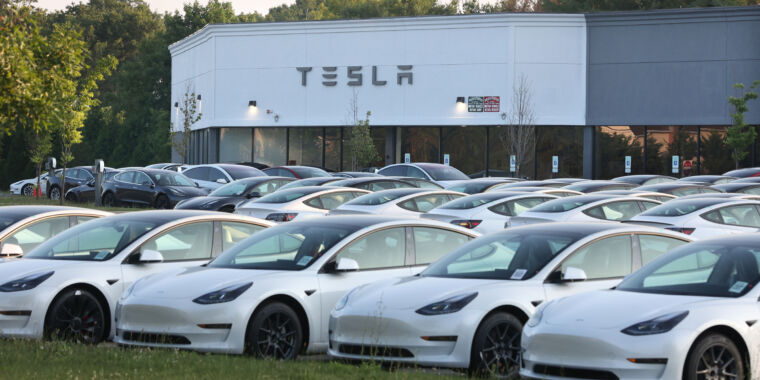John Paraskevas/Newsday RM via Getty Images
Tesla published its financial results for the last three months of 2023 this afternoon. The good news for the company is that it met its goal of delivering 1.8 million electric vehicles to customers, as Ars reported earlier this month when the automaker published that data. But a look at the company’s full financial results for Q4 are not as encouraging, and Tesla shares have fallen steeply in post-market trading.
Tesla brought in $25.2 billion in total revenue for Q4 2023, a year-over-year increase of 3 percent. Gross profits were down 23 percent for the quarter year over year, although net income (as determined by generally agreed accounting principles) increased 115 percent year over year. In large part, this was due to Tesla recording a “one-time non-cash tax benefit of $5.9 [billion] in Q4 for the release of valuation allowance on certain deferred tax assets”; non-GAAP income dropped 39 percent.
Free cash flow increased by 33 percent for the quarter, but its operating margin is almost half that of Q4 2022 at 8.2 percent.
For the entirety of 2023, total revenues stood at $96.8 billion, of which $82.4 billion came from automotive revenues, a 15 percent increase compared to 2022. Net profits for the year were 19 percent higher than 2022, but its margin for the year fell from 16.8 percent in 2022 to 9.2 percent in 2023, and for the year, free cash flow dropped by 42 percent.
The Model Y crossover is responsible for much of the company’s success in 2023—Tesla normally does not break out sales or deliveries between the Models 3 and Y, but revealed in its results slideshow that it delivered 1.2 million Model Ys last year, meaning that it also delivered about 500,000 Model 3 sedans. Plenty of price cuts helped make that happen in the US, Europe and China, where it is increasingly under pressure from the Chinese automaker BYD.
The company expanded its supercharger network last year by 27 percent, up to 5,952 stations with 54,892 ports. But not all of these are in North America—the US Department of Energy’s Alternative Fuels Data Center currently lists 2,339 Tesla Supercharger stations in the US and Canada, with 25,893 ports in total.
Tesla’s energy storage business continues to grow, deploying 14.7 GWh of battery storage, an increase of 125 percent year over year. But its solar activities continue to shrink, decreasing 36 percent year over year.
Unlike last year, or even last quarter, Tesla declined to issue specific guidance for the coming year other than saying it continues to work on its next-generation vehicle platform. In fact, the automaker warned that its vehicle growth rate may be “notably lower” in 2024. Earlier on Wednesday, unnamed sources told Automotive News that a compact crossover Tesla could appear in 2025.
Tesla’s stratospheric valuation—which remains far higher than any other automaker—has been built on promises of massive growth and tech-sector profit margins. With these results looking much more ordinary, analysts are starting to cool.
“Tesla delivered another underwhelming quarter, with a notable miss on automotive gross margins standing out the most. Tesla’s worrying China sales figures indicate demand for its vehicles is slowing more than expected in the face of rising competition from local EV companies, including BYD, Nio, and XPeng,” said Jesse Cohen, senior analyst at Investing.com. “I don’t think the price cuts are over, mainly for the reason that demand for its electric vehicles is still weak. The big question is if this is just a blip, or signs of a bigger shift among consumers as higher interest rates and a weaker economic backdrop discourage consumers from making big-ticket purchases.”
“After years of capacity-constrained volume and revenue growth, it seems Tesla is facing its first demand issues. The automaker has been cutting prices over the past year even as sales plateau—and the future doesn’t look bright,” said Karl Brauer, executive analyst at iSeeCars. “Updates to the Model 3 and the ramp up of Cybertruck production are positive news for 2024. But it’s hard to imagine those factors overcoming the increasingly competitive EV market, lower prices, softening sales, and compressed profit margin Tesla is facing over the next 12 months.”




